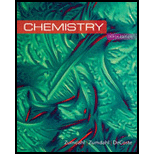
Concept explainers
(a)
Interpretation: The formulas for the given coordination compounds are to be stated.
Concept introduction: Rules should be followed to give formula to any coordination compound. Cations are named before anions and the ligands are named before the metal ion. Prefixes are used to denote the number of ligands. Oxidation state of central metal ion is designated by a roman numeral in parentheses. Ligands are named alphabetically.
To determine: The formula of given coordination compound.
(b)
Interpretation: The formulas for the given coordination compounds are to be stated.
Concept introduction: Rules should be followed to give formula to any coordination compound. Cations are named before anions and the ligands are named before the metal ion. Prefixes are used to denote the number of ligands. Oxidation state of central metal ion is designated by a roman numeral in parentheses. Ligands are named alphabetically.
To determine: The formula of given coordination compound.
The formula of given coordination compound is
(c)
Interpretation: The formulas for the given coordination compounds are to be stated.
Concept introduction: Rules should be followed to give formula to any coordination compound. Cations are named before anions and the ligands are named before the metal ion. Prefixes are used to denote the number of ligands. Oxidation state of central metal ion is designated by a roman numeral in parentheses. Ligands are named alphabetically.
To determine: The formula of given coordination compound.
(d)
Interpretation: The formulas for the given coordination compounds are to be stated.
Concept introduction: Rules should be followed to give formula to any coordination compound. Cations are named before anions and the ligands are named before the metal ion. Prefixes are used to denote the number of ligands. Oxidation state of central metal ion is designated by a roman numeral in parentheses. Ligands are named alphabetically.
To determine: The formula of given coordination compound.
(e)
Interpretation: The formulas for the given coordination compounds are to be stated.
Concept introduction: Rules should be followed to give formula to any coordination compound. Cations are named before anions and the ligands are named before the metal ion. Prefixes are used to denote the number of ligands. Oxidation state of central metal ion is designated by a roman numeral in parentheses. Ligands are named alphabetically.
To determine: The formula of given coordination compound.
Trending nowThis is a popular solution!

Chapter 21 Solutions
Bundle: Chemistry, Loose-leaf Version, 10th + Enhanced Webassign Printed Access Card For Chemistry, Multi-term Courses
- Synthesize 2-Ethyl-3-methyloxirane from dimethyl(propyl)sulfonium iodide using the necessary organic or inorganic reagents. Draw the structures of the compounds.arrow_forwardSynthesize 2-Hydroxy-2-phenylacetonitrile from phenylmethanol using the necessary organic or inorganic reagents. Draw the structures of the compounds.arrow_forwardSynthesize N-Methylcyclohexylamine from cyclohexanol using the necessary organic or inorganic reagents. Draw the structures of the compounds.arrow_forward
- Synthesize N-Methylcyclohexylamine from cyclohexanol using the necessary organic or inorganic reagents. Draw the structures of the compounds.arrow_forwardIf possible, please provide the formula of the compound 3,3-dimethylbut-2-enal.arrow_forwardSynthesize 1,4-dibromobenzene from acetanilide (N-phenylacetamide) using the necessary organic or inorganic reagents. Draw the structures of the compounds.arrow_forward
- Indicate the products obtained by mixing (3-oxo-3-phenylpropyl)triphenylphosphonium bromide with sodium hydride.arrow_forwardWe mix N-ethyl-2-hexanamine with excess methyl iodide and followed by heating with aqueous Ag2O. Indicate the major products obtained.arrow_forwardIndicate the products obtained by mixing acetophenone with iodine and NaOH.arrow_forward
- Indicate the products obtained by mixing 2-Propanone and ethyllithium and performing a subsequent acid hydrolysis.arrow_forwardIndicate the products obtained if (E)-2-butenal and 3-oxo-butanenitrile are mixed with sodium ethoxide in ethanol.arrow_forwardQuestion 3 (4 points), Draw a full arrow-pushing mechanism for the following reaction Please draw all structures clearly. Note that this intramolecular cyclization is analogous to the mechanism for halohydrin formation. COH Br + HBr Brarrow_forward
 Chemistry: Principles and PracticeChemistryISBN:9780534420123Author:Daniel L. Reger, Scott R. Goode, David W. Ball, Edward MercerPublisher:Cengage Learning
Chemistry: Principles and PracticeChemistryISBN:9780534420123Author:Daniel L. Reger, Scott R. Goode, David W. Ball, Edward MercerPublisher:Cengage Learning ChemistryChemistryISBN:9781305957404Author:Steven S. Zumdahl, Susan A. Zumdahl, Donald J. DeCostePublisher:Cengage Learning
ChemistryChemistryISBN:9781305957404Author:Steven S. Zumdahl, Susan A. Zumdahl, Donald J. DeCostePublisher:Cengage Learning Chemistry: An Atoms First ApproachChemistryISBN:9781305079243Author:Steven S. Zumdahl, Susan A. ZumdahlPublisher:Cengage Learning
Chemistry: An Atoms First ApproachChemistryISBN:9781305079243Author:Steven S. Zumdahl, Susan A. ZumdahlPublisher:Cengage Learning
 General Chemistry - Standalone book (MindTap Cour...ChemistryISBN:9781305580343Author:Steven D. Gammon, Ebbing, Darrell Ebbing, Steven D., Darrell; Gammon, Darrell Ebbing; Steven D. Gammon, Darrell D.; Gammon, Ebbing; Steven D. Gammon; DarrellPublisher:Cengage Learning
General Chemistry - Standalone book (MindTap Cour...ChemistryISBN:9781305580343Author:Steven D. Gammon, Ebbing, Darrell Ebbing, Steven D., Darrell; Gammon, Darrell Ebbing; Steven D. Gammon, Darrell D.; Gammon, Ebbing; Steven D. Gammon; DarrellPublisher:Cengage Learning




